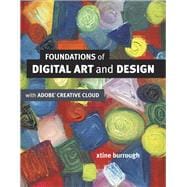Fuses design fundamentals and software training into one cohesive book!
- Teaches art and design principles with references to contemporary digital art alongside basic digital tools in Adobe's Creative Cloud
- Addresses the growing trend of compressing design fundamentals and design software into the same course in universities and design trade schools.
- Lessons are timed to be used in 50 to 90 minute class sessions with additional materials available online
- Free video screencasts demonstrate key concepts in every chapter
All students of digital design and production—whether learning in a classroom or on their own—need to understand the basic principles of design. These principles are often excluded from books that teach software. Foundations of Digital Art and Design reinvigorates software training by integrating design exercises into tutorials fusing design fundamentals and core Adobe Creative Cloud skills. The result is a comprehensive design learning experience.
This book is organized into six sections that focus on vector art, photography, image manipulation, typography, web design, and effective habits. Design topics and principles include: Bits, Dots, Lines, Shapes, Rule of Thirds, Zone System, Color Models, Collage, Appropriation, Gestalt, The Bauhaus Basic Course Approach, The Grid, Remix, Automation, and Revision.








